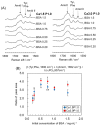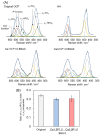Adsorption of Serum Albumin onto Octacalcium Phosphate in Supersaturated Solutions Regarding Calcium Phosphate Phases
- PMID: 31340468
- PMCID: PMC6678651
- DOI: 10.3390/ma12142333
Adsorption of Serum Albumin onto Octacalcium Phosphate in Supersaturated Solutions Regarding Calcium Phosphate Phases
Abstract
Octacalcium phosphate (OCP) has been shown to enhance new bone formation, coupled with its own biodegradation, through osteoblasts and osteoclast-like cell activities concomitant with de novo hydroxyapatite (HA) formation and serum protein accumulation on its surface. However, the nature of the chemical environment surrounding OCP and how it affects its metabolism and regulates protein accumulation is unknown. The present study examined how the degree of supersaturation (DS) affects the bovine serum albumin (BSA) adsorption onto OCP in 150 mM Tris-HCl buffer at 37 °C and pH 7.4, by changing the Ca2+ ion concentration. The amount of BSA adsorbed onto OCP increased as the DS increased. In addition, the amount of newly formed calcium phosphate, which could be OCP, was increased, not only by increases in DS, but also at lower equilibrium concentrations of BSA. The increased adsorption capacity of BSA was likely related to the formation of calcium phosphate on the adsorbed OCP. Together the results suggested that the formation of new calcium phosphate crystals is dependent on both the DS value and the adsorbate protein concentration, which may control serum protein accumulation on the OCP surface in vivo.
Keywords: bovine serum albumin; degree of supersaturation; octacalcium phosphate; protein adsorption.
Conflict of interest statement
The authors declare no conflict of interest but the content of the present study was used for a patent application.
Figures









Similar articles
-
Adsorption of Serum Fetuin onto Octacalcium Phosphate and Its Relation to Osteogenic Property.Int J Mol Sci. 2025 Feb 6;26(3):1391. doi: 10.3390/ijms26031391. Int J Mol Sci. 2025. PMID: 39941160 Free PMC article.
-
Comparative analysis of bovine serum albumin adsorption onto octacalcium phosphate crystals prepared using different methods.Dent Mater J. 2020 Sep 29;39(5):883-891. doi: 10.4012/dmj.2019-250. Epub 2020 May 22. Dent Mater J. 2020. PMID: 32448850
-
In vitro crystallization of octacalcium phosphate on type I collagen: influence of serum albumin.J Mater Sci Mater Med. 1999 Mar;10(3):153-60. doi: 10.1023/a:1008933406806. J Mater Sci Mater Med. 1999. PMID: 15348163
-
The material design of octacalcium phosphate bone substitute: increased dissolution and osteogenecity.Acta Biomater. 2023 Mar 1;158:1-11. doi: 10.1016/j.actbio.2022.12.046. Epub 2022 Dec 27. Acta Biomater. 2023. PMID: 36581004 Review.
-
Bone regeneration by synthetic octacalcium phosphate and its role in biological mineralization.Curr Med Chem. 2008;15(3):305-13. doi: 10.2174/092986708783497283. Curr Med Chem. 2008. PMID: 18288986 Review.
Cited by
-
Mutual chemical effect of autograft and octacalcium phosphate implantation on enhancing intramembranous bone regeneration.Sci Technol Adv Mater. 2021 May 28;22(1):345-362. doi: 10.1080/14686996.2021.1916378. Sci Technol Adv Mater. 2021. PMID: 34104115 Free PMC article.
-
Design Strategies and Biomimetic Approaches for Calcium Phosphate Scaffolds in Bone Tissue Regeneration.Biomimetics (Basel). 2022 Aug 13;7(3):112. doi: 10.3390/biomimetics7030112. Biomimetics (Basel). 2022. PMID: 35997432 Free PMC article. Review.
-
Electrophoretic Deposition of Calcium Phosphates on Carbon-Carbon Composite Implants: Morphology, Phase/Chemical Composition and Biological Reactions.Int J Mol Sci. 2024 Mar 16;25(6):3375. doi: 10.3390/ijms25063375. Int J Mol Sci. 2024. PMID: 38542348 Free PMC article.
-
Adsorption of Serum Fetuin onto Octacalcium Phosphate and Its Relation to Osteogenic Property.Int J Mol Sci. 2025 Feb 6;26(3):1391. doi: 10.3390/ijms26031391. Int J Mol Sci. 2025. PMID: 39941160 Free PMC article.
References
-
- Brown W.E., Smith J.P., Frazier A.W., Lehr J.R. Crystallographic and chemical relations between octacalcium phosphate and hydroxyapatite. Nature. 1962;196:1050–1055. doi: 10.1038/1961050a0. - DOI
-
- Brown W.E., Mathew M., Tung M.S. Crystal chemistry of octacalcium phosphate. Prog. Cryst. Growth Charact. 1981;4:59–87. doi: 10.1016/0146-3535(81)90048-4. - DOI
Grants and funding
LinkOut - more resources
Full Text Sources
Miscellaneous

